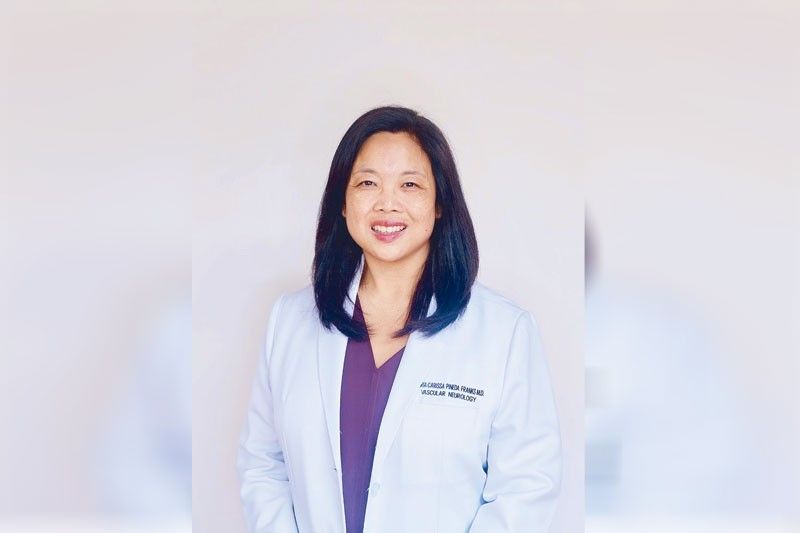Before a stroke strikes

We asked stroke specialist Dr. Carissa “Rissa” Pineda Franks to give us some important information regarding strokes. Dr. Franks is a graduate of the University of the Philippines College of Medicine. She took her residency training in Adult Neurology at the Thomas Jefferson University Hospital in Philadelphia, and fellowship in Stroke and Neurocritical Care also at the Thomas Jefferson University Hospital. After graduation from fellowship, she joined the faculty at the Department of Neurology in the same institution, as an associate professor.
To date, strokes remain the second leading cause of death and the leading cause of disability in the world. We don’t really realize the gravity of this disease until a loved one or people we know are afflicted with a stroke or worse, die of a stroke. Strokes affect the arteries leading to or within one’s brain. A stroke is when the blood supply that carries oxygen to the brain is either blocked by a clot or ruptures in the brain.
We asked Dr. Rissa what made her get into this field. “At first, I really found neurology very confusing and overwhelming because of all the difficult names of the tracts, but once I understood how they were all connected, I was intrigued with how logical the brain works and how this could explain a lot of things that are going on in your body. As for the sub-specialization of stroke, although it is a devastating and complex disease, I’d like to think that there is hope in getting better from a very bad state with the many new treatments that are being discovered.”

Dr. Rissa tells us it is important to consult a doctor if you have unexplained symptoms that pertain to your brain, spinal cord, and nerves. Some examples of symptoms are: headaches, dizziness, numbness or tingling, movement problems and memory issues.
For those who want to become a neurologist, here are the pros and cons, according to Dr. Rissa. “The pros: hopefully, being able to make an impact on patients’ lives by helping them understand their diagnosis, although sometimes even the neurologist cannot explain fully the condition. And cons: being called for neurological emergencies at any time of the day.
We close this interview with Dr. Rissa’s guiding principle in life: “Everything happens for a reason, whether it is happy, sad or confusing.”
Read on as Dr. Rissa Pineda Franks tells us the 10 important things to know about a stroke.
1. Strokes are not just for the elderly — it can occur at any age; therefore, anyone can have a stroke. The incidence of a stroke increases after age 65. However, about 20 percent of strokes may happen to those under age 50.
2. A stroke is an emergency. Time lost is brain lost. During a stroke, nearly 120 million brain cells die every hour. There is a very narrow time window for the treatment of stroke to be administered; if this is missed, it may lead to more brain damage and more disability. The sooner you seek help for a stroke, the sooner you can be treated.
3. Know how to spot a stroke. The most common warning signs of a stroke can be remembered with the acronym B.E.F.A.S.T. B - Balance: Watch for sudden loss of balance. E - Eyes: Check for vision loss. F - Face: Look for an uneven smile. A - Arm: Check if one arm is weak. S - Speech: Difficulty in speech. T - Time: Time to call for an ambulance immediately.
4. Not all strokes are the same; there are different types of strokes. Ischemic strokes are caused by a blockage of an artery; hemorrhagic strokes are due to a rupture of an artery in the brain, while a transient ischemic attack (TIA) is caused by a temporary blockage of an artery. Eighty-seven percent of all strokes are ischemic.
5. Both heart disease and strokes share many risk factors, such as high cholesterol, high blood pressure, smoking, diabetes and physical inactivity. Hypertension is the most common preventable cause of a stroke.
6. Up to 80 percent of strokes can be prevented. Although there are some stroke risk factors that are out of your control (family history, age, sex and race), the majority of the other risk factors can be controlled through medications and lifestyle modification, such as eating a balanced diet, exercising regularly, quitting smoking, exercising more, and lowering your alcohol intake.
7. Having a stroke increases the risk of a second one (one in four survivors have another stroke). The succeeding strokes may be more debilitating than the previous one. This is why it is important to control your risk factors.
8. Poor lifestyle and uncontrolled parameters of your blood pressure, cholesterol and blood sugar greatly contribute to your risk of having a stroke. Do not just stop taking your medications without the knowledge of your physician.
9. Despite an extensive workup with many tests done in the hospital, there may be instances that the cause of the ischemic stroke is unknown — these are called cryptogenic strokes. It’s a challenge to prevent a second stroke when the cause of the first one is unknown.
10. Most stroke cases will require rehabilitation. The first three months after a stroke is the period when the brain tries to relearn many things.
(We welcome your suggestions and comments. Please e-mail me at [email protected]. Follow me on Instagram @monsromulo.)
- Latest





























